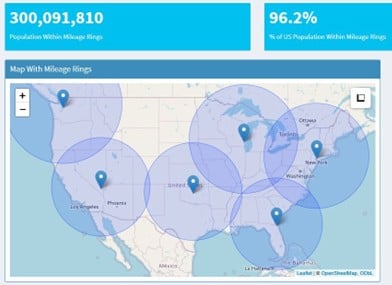How Many Distribution Centers Are Needed For One-Day Delivery?

Editor’s note: This is Part 1 of a two-part series on selecting distribution center locations.
***
When designing your supply chain, proximity matters. For both B2B and B2C organizations, it is vital to consider how far your distribution centers (DCs) are from your customer base, and the impact that distance has upon service level and operational cost.
Grocers may locate their temperature-controlled DCs within a day’s drive from all stores to ensure food freshness, while e-commerce retailers may guarantee two-day shipping to all customers, thus locating fulfillment centers accordingly.
How are DC locations selected to meet these goals?
Doing the Math
First, you need to know the driving distances from your potential DCs to your customers.
Sounds simple, right? It’s not: It is prohibitively difficult to find the driving distance from all possible DC locations to all possible customer locations. For most firms, it would be impractical to use a service like Google Maps to find the driving distance and time for all DC-customer pairs under consideration.
In supply chain design, you can avoid this real-life complication through approximation. Given the latitude and longitude of an origin and destination, computers can quickly and easily calculate and find the straight-line distance (“as the crow flies”) between the two points. (For those interested, this involves trigonometry.)
Then, tack on an extra 15 percent or so — often called a “circuity factor” — to the straight-line distance, and the result will generally be pretty close to the actual driving distance. This approximation allows you to quickly establish how much of the country can be reached from your DCs within a certain driving time.
For example, suppose your planning factors that a truckload driver can drive for 600 miles a day. With a 15-percent circuity factor (meaning that the road distance from A to B is 15 percent longer than the straight-line distance from A to B), here is how to determine a solution (using algebra):
- x road miles = y straight-line miles x (100 percent + 15 percent circuity factor)
- 600 road miles = (y straight-line miles) x 1.15
- 600/1.15 = 521.74 straight-line miles.
So, if your planning factor is 600 road miles a day, you can draw a circle on the map around our potential DC locations with a radius of 521.74 miles. Points on the map that fall within that circle are approximately reachable within a day.
Mapping DCs
Suppose a grocery store chain is reimagining its distribution footprint. Executive guidance is to cover as much of the U.S. as possible within one day’s drive, without over-investing in DCs. A working group suggests building five DCs: in Las Vegas, Chicago, Dallas, Atlanta and Philadelphia.
The circles on the map below, with a radius of 521.74 miles around each of the five DCs, show how much of the United States can be reached within a one-day drive. The covered areas represent about 90 percent of the population. That’s not bad!

(Courtesy of Data Driven Supply Chain LLC)
(The map was created using an app from my company, Data Driven Supply Chain LLC. Try the app here. Instructions are in the About tab.)
Apps like these work well when there is a starting hypothesis, such as having five cities you want to place your DCs in. But what if you have only such starting guidance as you want to cover at least 95 percent of the country within a day’s drive from your DCs? This is where optimization, the math underlying supply chain design software, shines.
After building an optimization model in an open-source programming language like Python or R, give the model:
- A list of candidate DC locations, like the top 50 metro areas listed above
- Maximum driving distance from the DCs (like 600 road miles, representing a day’s drive)
- Circuity factors.
The model will then provide a list of DC locations (metro areas) that will provide 95-percent coverage within a day’s drive, while minimizing the total number of buildings. Shown in the map below, the model suggests building DCs in New York, Seattle, Las Vegas, Milwaukee, Oklahoma City and Jacksonville, Florida.

(Courtesy of Data Driven Supply Chain LLC)
It’s important to note that these may not be the only possible list of six DCs that provide 95-percent coverage within a day’s drive. And this coverage model is fairly simplistic, as it does not include costs or capacity constraints at DCs. Still, it’s a good starting point for discussions and can lead to more comprehensive supply chain design models, with important inputs like costs and capacity constraints.
The second article in the series will cover hyperlocal supply chains: How does this approach differ when we’re talking about 30-minute delivery, not one-day delivery?

